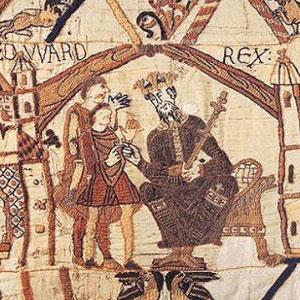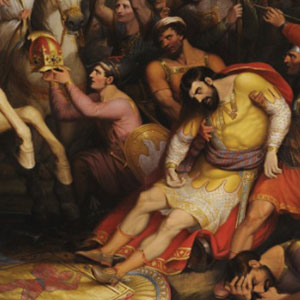Activity 2
What is the Bayeux Tapestry? Is it a true historical account?
The Bayeux Tapestry is a story in pictures of the events leading up to the bloody battle in 1066 between two very powerful men and their armies. Each wanted to become king of England – one would die trying. The tapestry is more than 900 years old and is the only contemporary record that we have of the events leading up to and including the Battle of Hastings.
In the mid C11th the people of England lived in relative peace although potential rivalry for power simmered beneath the surface. On January 5, 1066, King Edward the Confessor died without leaving an heir to the throne and a power struggle soon resulted.
The earls of Mercia, Northumbria, and other lands entered into open rivalry for power. One in particular was the Norman knight, William I, the Duke of Normandy who assembled his army in preparation for a challenge.
In the meantime Harold Godwinson – the Earl of Wessex and the richest and most powerful aristocrat in Anglo-Saxon England was crowned king. He was aware of William’s intention to sail but first he had another enemy to face – the king of Norway, Harald Hardrada (supported by the Tostig, the king’s own brother) who landed at the north of England to mount his own challenge.
In the ensuing battle the king of Norway was killed and almost his entire army put to the sword. Now it was time for King Harold to meet the Norman army.

Click to find the locations on the map to help you with the story.
Your Task
Answer the questions below on screen or in this Word Doc version to save your answers.
Bayeux Tapestry Facts
History mystery detectives need to use evidence to solve mysteries – that is, you may not completely believe an account and want to investigate further to discover the truth. Here are some facts about the Bayeux Tapestry. Decide whether these facts make you:
- Confident that the tapestry is showing you the truth OR Not confident that the tapestry will always be accurate.
Tick the column that tells you what you think.
| This fact about the tapestry makes me... | Confident it tells the truth |
Think the tapestry may not be accurate |
|---|---|---|
The tapestry gives us a very detailed account of what happened at the time. |
||
The tapestry is very accurate in terms of details of what things looked like e.g. clothes, weapons, ships. |
||
The tapestry was made 20 years after the events it is telling us about. |
||
The artist who made the tapestry was not at the events it tells us about. |
||
The artist got the story from people who were there at the time. |
||
The artist made the tapestry to please the winners of the battle. |
||
The tapestry was made on the orders of a bishop. |

